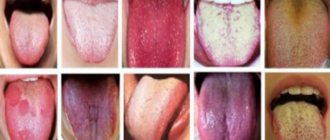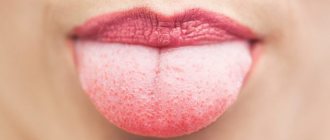The appearance of plaque on the tongue is not uncommon for anyone. People may often notice whitish deposits, which are normal in most cases and can be easily removed with special brushes. However, in rare cases, patients experience severe changes in the color of the tongue. When faced with dark plaque for the first time, people do not understand which doctor to contact and what diseases this unusual symptom may indicate.
- 5 How to remove dark plaque on the tongue?
- 6 Treatment prognosis and possible complications
- 7 Prevention
What does a black coating on the tongue mean?
Language is a unique indicator of human health. By its appearance, since ancient times, doctors could make a diagnosis and it was believed that the patient had recovered if the surface of this organ returned to a light pink hue. There are various external factors that influence the type of plaque. Sometimes it can even change with the change of season. During a meal, pieces of food are retained between the taste buds and bacteria begin to multiply intensively in these areas, staining the surface of the tongue with the products of their vital activity. Sometimes a dark coating can appear in smokers, coffee drinkers, and red wine drinkers. It can be easily removed using a special scraper or by rinsing the mouth and it will not be a symptom of any disease.
If, when brushing your teeth in the mirror, you suddenly discover that instead of a pinkish surface, a dark coating is visible on the tongue, then in most cases this indicates serious disorders in the body. The more difficult it is to remove and the denser it is in consistency, the more severe and advanced the primary disease.
Dark plaque may appear due to illness or consumption of coloring products.
Black tongue options
Usually the patient notices a black coating on the tongue on his own. Such blackening can occur in the form of symptoms:
- black spots or many dots over the entire surface, often with a blue-green tint;
- one large spot;
- dark areas in the central part;
- dense plaque with cracks or bleeding spots underneath;
- transition of plaque to the dentition;
- continuous blackening without plaque;
- with a putrid odor in the mouth;
- with increased relief and symptoms of swelling.
Types and colors - brown, gray, black, etc.
While for an ordinary person the details may not be important, the doctor very carefully studies the smallest details in the appearance of the tongue. There are many different shades of dark plaque:
- black can be a symptom of kidney pathology, nephritis;
- light brown indicates diseases of the skeletal and respiratory systems;
- yellow-brown is often observed with alcoholism, diseases of the gastrointestinal tract, and excessive use of drugs;
- dark brown occurs with dehydration, acute abdomen and serious disorders of the gastrointestinal tract;
- gray and dark gray can indicate chronic stomach diseases and constipation, candidiasis;
- purple indicates stagnation in the circulatory system;
- gray-green or brown-green occurs with cholecystitis and nephritis, oral candidiasis;
- gray-blue is found in Crohn's disease and cholera.
It is also important to evaluate its consistency. It can be dry or moist, fatty and cheesy. All these nuances indicate exactly how the disease progresses. It is necessary to see whether it is easily removed and whether there is any pain during this procedure.
The location of plaque on the surface of the tongue is studied separately:
- plaque on the tip of the tongue indicates diseases of the cardiovascular system;
- along the edges - about lung diseases;
- at the base of the tongue - about pathologies of the gastrointestinal tract;
- on the sides at the base - about liver and spleen disease.
Video about diseases that the tongue can talk about
Inflammatory pathologies of the oral cavity
Pharyngitis or chronic tonsillitis
in the acute stage, they can also lead to the appearance of a black “sediment” on the tongue. Its distinctive feature is its presence after waking up and its almost complete disappearance after eating or hygienic cleaning.
Sometimes a black coating appears on the tonsils and tongue in combination with an increase in body temperature. Such symptoms are characteristic of tonsillitis (acute tonsillitis). Sore throat does not occur without a sore throat, so making a diagnosis in such a situation is quite simple. When the disease passes, the unpleasant manifestations of the tongue will also disappear.
Sometimes black spots form after suffering from the flu - this is how glossitis, or inflammation of the tongue, occurs.
Oddly enough, sometimes a black tongue means the development of oral candidiasis, or thrush
. Typically, this pathology manifests itself as white cheesy masses localized in the mouth, but advanced stages cause darkening of the plaque. The disease is accompanied by bad breath, burning, tingling, and tissue swelling.
Causes and factors of appearance
Sometimes a dark coating on the tongue may appear due to the use of certain foods or medications. Also, this symptom may be a consequence of special conditions of the body or external influences.
- Taking some medications can cause a light brown coating on the tongue. It appears due to the abuse of drugs such as Malavit, Faringosept, and steroid drugs.
- The use of drugs containing bismuth, which are used for gastritis and heartburn (Vicalin, De-nol, Ulcavis).
- Lack of vitamin PP or nicotinic acid in the body.
- A lack of B vitamins, in addition to dark plaque, can also lead to the appearance of teeth marks on the tongue.
- In smokers, smoke, phenols and nicotinic acid can constantly stain not only the tongue, but also the teeth in brownish shades.
- Excessive consumption of fatty meat, sweets, chocolate, and sweet baked goods leads to an imbalance in the acid-base balance, the body gradually becomes acidic, and patients develop acidosis. Also, such a diet contributes to a lack of vitamins, which are abundant in fruits and vegetables.
- The body's contamination with various toxins can also cause the appearance of plaque on the tongue.
- Lead poisoning often appears as small black spots all over the tongue. In this case, the edges of the gums become grayish, and a metallic taste is felt in the oral cavity. This condition also has a synonym - Remak syndrome.
- Dehydration can also cause brown plaque to appear. This is especially common with long-term toxicosis in pregnant women.
- Alcohol abuse and chronic alcoholism have a detrimental effect on the condition of the entire body. The liver, kidneys, cardiovascular system and organs of the gastrointestinal tract are affected. There is also constant dehydration of the body and disruption of the microflora, which leads to the appearance of a dark coating on the tongue.
Lead poisoning may occur due to consumption of vegetables treated with pesticides containing heavy metals.
In most cases, a dark coating on the tongue of patients indicates various serious diseases. Sometimes these can be diseases of the oral cavity.
- Oral candidiasis develops due to fungi of the same name. At the first stage of the disease, the tongue is covered with a dense white coating, but later it gradually darkens and acquires a gray or light brown tint. Often, when cleansing, ulcers remain on the mucous membrane, which are very itchy and sometimes even bleed.
- Advanced stomatitis is a serious threat even to human life, since the infection can affect internal organs, such as the lungs. In addition to plaque on the tongue, patients also develop painful ulcers.
- Chromogenic fungus in the mouth contributes to the formation of plaque not only on the tongue, but throughout the entire oral cavity. The teeth, gums and cheeks are covered with dark green spots.
- Disturbance of the microflora of the oral cavity due to various diseases and the use of antibiotics. These drugs destroy not only pathogenic microorganisms, but also those necessary for normal life.
Chromogenic fungus leads to plaque not only on the tongue, but also on the gums and teeth
Most often, patients are diagnosed with all sorts of diseases of the gastrointestinal tract, which lead to a dark coating on the tongue.
- Severe or corrosive gastritis is an inflammation of the gastric mucosa due to the ingress of various acidic or alkaline solutions and radioactive substances.
- Fibrinous gastritis develops due to various purulent processes in the stomach. This disease is quite rare and usually appears during infectious infection with the measles virus, scarlet fever, or typhoid fever.
- Peptic ulcers are most often found in men between the ages of 20 and 50. Alcoholism may be a provoking factor. The disease is accompanied by a sour taste, severe stomach pain, nausea and vomiting.
- Stones and inflammatory processes in the ducts of the salivary glands can also lead to the appearance of dark plaque. At the same time, the surface of the tongue is very dry, it may even crack.
- Enterocolitis or inflammation of the small and large intestines can also cause a brown coating on the tongue.
- Crohn's disease is an autoimmune disease that causes chronic constipation and an increase in melanin in the body. Patients experience adrenal dysfunction and the appearance of blue-black spots throughout the body. The course of the disease is chronic; patients constantly experience inflammation of various parts of the digestive tract. Another name for Crohn's disease is granulomatous enteritis.
- Dysbacteriosis or a violation of the microflora composition greatly affects digestion and absorption of nutrients in the intestines. This can happen due to various factors: bad habits, taking antibiotics, stress and even poor ecology. Due to the increased proliferation of pathogenic microorganisms in the oral cavity, a dark coating may appear on the tongue.
- Diseases of the pancreas can also cause the appearance of a dark brown coating on the surface of the tongue. Very often, pain in the hypochondrium, bitter taste, dehydration, nausea and vomiting are also present.
- Liver pathology is accompanied by bitterness in the mouth and the appearance of a brownish-yellowish coating on the tongue. Patients are concerned about pain in the right hypochondrium, nausea, weight loss. Sometimes jaundice appears, in which the skin and mucous membranes acquire a yellow tint.
- Cholecystitis is an inflammatory process in the gallbladder. This can happen due to infection with intestinal microflora due to a violation of the outflow of bile. Patients develop fever, severe pain, nausea, and vomiting. Most often, this disease is registered in women due to various processes during pregnancy and hormonal levels. Due to stagnation of bile, a yellowish and brown coating may appear on the tongue.
- Chronic constipation without an inflammatory process can also cause the appearance of a gray coating on the tongue.
Disturbances in the composition of microflora negatively affect the condition of the whole organism
But it is not always diseases of the gastrointestinal tract that lead to the appearance of a dark coating on the tongue. Sometimes the cause may be various infectious diseases, as well as pathologies of other internal organs.
- Respiratory diseases can also cause brown plaque. Patients are found to have pneumonia, bronchitis, and tracheitis.
- Arthritis is an inflammatory disease of the joints. It develops due to the action of infections, injuries, as well as allergic, dystrophic and reactive processes in the body. Despite the fact that the main symptoms are associated specifically with pain in the skeletal system, some patients experience a dark coating on the tongue.
- Autoimmune blood diseases that are inherited. These include hemolytic anemia and erythropoietic uroporphyria. In these diseases, patients experience constant destruction of red blood cells, called hemolysis.
- ARVI manifests itself differently in patients. Some may experience a slight fever, while others may have more severe symptoms and may also develop a dark coating on the tongue.
- HIV infection leads to a decrease in the body's resistance to all kinds of pathogens due to disorders in the immune system. All this contributes to the growth of bacteria in the oral cavity, which can color the tongue in various colors, including gray, brown and black.
- Sore throat is an acute infectious disease that affects the palate and tonsils. Patients complain of very severe pain; it becomes almost impossible to swallow food. The proliferation of pathogenic microorganisms in the oral cavity contributes to the formation of various coatings on the tongue, including dark ones.
- Lymphostasis is a disease in which the functioning of the lymphatic system is disrupted. Patients exhibit swelling, severe thickening of the limbs, and a beige coating on the surface of the tongue.
- Nephritis is an inflammatory disease of the kidneys, which very often leads to disruption of the structure of these organs. In patients, the excretory function is weakened, severe pain appears in the lumbar region, the amount of urine decreases, appetite decreases, nausea and vomiting appear. This disease is very serious and if not treated promptly, a kidney transplant may be required.
- Diabetic coma occurs in patients with diabetes due to a lack of insulin in the body. In this condition, the tongue is dry, cracked, and covered with a brownish-brown coating.
- Addison's disease or hypocortisolism is a chronic insufficiency of the adrenal cortex, which loses the ability to produce the required amount of cortisol.
- Cholera is a very dangerous intestinal infectious disease that occurs due to infection with Vibrio cholerae. Patients suffer from constant bouts of vomiting, dehydration and very high fever.
Treatment of black plaque
To determine the cause of unpleasant symptoms and properly treat the disease, you must first make an appointment with a therapist. After diagnosis, the patient may need:
- A dentist who provides dental and oral treatment.
- Infectious disease specialist to eliminate the source of infection.
- Gastroenterologist to eliminate inflammatory processes in the intestines and stabilize the microflora.
- A pulmonologist who deals with respiratory diseases.
- Toxicologist, endocrinologist and other specialists.
All this will eliminate pathological layers on the mucous membrane and return the tongue to its natural color. The body could use multivitamin support to stabilize its defenses. It is useful to rinse the mouth with pharmaceutical products and infusions of sage, St. John's wort, and chamomile. Use special products and decoctions as prescribed by your doctor. Only he can develop the correct therapy program.
As practice has shown, the best way to prevent plaque is systematic oral hygiene. In this case, soft brushes and scraping spoons recommended by a specialist are used. Rinse your mouth even after a snack. If possible, reduce the number of cigarettes you smoke per day. Don't get carried away with sugary energy drinks; it's better to switch to healthy and nutritious smoothies.
Diagnosis and differential diagnosis
To find out exactly what disease led to the appearance of a dark coating on the tongue, you need to consult a doctor. First of all, it is better to visit a therapist who will conduct an examination and collect the patient’s medical history. The patient's abdomen is palpated, the function of the lungs and heart is listened to, and bad habits, diseases, and injuries are also found out. Based on these data, the therapist will give a referral to a specific specialist.
The patient may be prescribed the following examinations:
- general blood analysis;
- blood chemistry;
- urine and stool analysis;
- fluorography;
- Ultrasound of internal organs;
- gastroscopy, etc.
Most often, the patient has to visit a gastroenterologist who specializes in diseases of the gastrointestinal tract. A referral to an infectious disease specialist and endocrinologist may also be issued.
Gastroscopy allows you to examine the mucous membrane of the esophagus and stomach using a special endoscope
When a raid is not dangerous
If a black coating appears on your tongue, do not panic. The most common reason is the use of products with coloring properties:
- strong tea or coffee;
- spices;
- black berries (black currant, chokeberry, blueberry, mulberry);
- juices (usually purchased);
- sweets, lollipops, chewing gum;
- activated carbon.
There are known cases of darkening of the tongue after active smoking for several days.
Many foods contain dyes. If this is the reason for blackness, then there is nothing wrong with changing the language. In such cases, rinsing the tongue and brushing it with a toothbrush will help.
How to remove dark plaque on the tongue?
Patients are advised to perform oral hygiene procedures daily. It is necessary to brush your teeth and the surface of your tongue at least twice a day. It is best to use a special plastic scraper for this, which will not injure the delicate surface of the tongue. You can use special gels, which are applied to the darkened mucous membrane for a few minutes, and then rinse thoroughly and spit out the used product. You should also use dental floss at least once a week to remove food particles from hard-to-reach places. In case of acidosis, patients are prescribed to drink plenty of fluids and take soda solutions orally.
Video on how to properly clean your tongue
It is impossible to get rid of dark plaque on the tongue without treating the underlying disease. Based on the established diagnosis, the doctor prescribes treatment for each patient individually.
Drug therapy
- For stomatitis, it is necessary to rinse every two hours with local antiseptics (Hepilor, Chlorophyllipt, Tantum Verde).
- Antifungal agents are prescribed for candidiasis (Clotrimazole, Fluconazole, Pimafucin).
- Probiotics containing live bifidobacteria and lactobacilli are necessary to restore intestinal microflora (Linox, Acipol, Bifidumbacterin).
- Prebiotics stimulate the body to produce its own bacteria by containing a nutrient medium for them (Duphalac, Normaze, Lactusan).
- Drugs to strengthen the immune system are necessary to increase the body's resistance to harmful substances (Cycloferon, Ribomunil, Kagocel).
- Local disinfectants are necessary for sanitation of the oral cavity. You can use Chlorhexidine, Rezocin solution, Salicylic alcohol.
- Drugs that stimulate the secretion of gastric juice are necessary for gastritis with low acidity (Limontar, Prozerin, Etimizol).
- Antibacterial agents are needed for the treatment of aggressive types of gastritis (Cephalexin, Enterofuril, Furazolidone).
- Sorbents are used to eliminate toxic substances from the body (activated carbon, Enterosgel).
- Antacids are necessary for gastritis with high acidity and heartburn (Rennie, Phosphalugel, Maalox).
- Preparations to enhance the protection of the gastric mucosa (De-Nol, Biogastron, Venter).
- Vitamins B and PP must be used if they are deficient in the body.
Diet
Sometimes, to get rid of dark plaque on the tongue, it is enough to follow a special diet for a long time, aimed at normalizing the acid-base balance and metabolism. To alkalize the body, you should consume more of the following foods:
- greenery;
- citruses;
- avocado;
- cabbage;
- tomatoes;
- potato;
- radish;
- turnip;
- garlic;
- dried fruits.
For the body to function properly, it is necessary to consume more “alkaline” foods.
If there is a lack of nicotinic acid, patients are advised to increase their consumption of meat, liver, egg yolks, milk, legumes, buckwheat, and peanuts. An adult needs to consume about 15 mg of vitamin PP per day.
Also, for the health of the body, it is worth reducing the consumption of the following foods:
- sweets;
- carbonated drinks;
- fast food;
- smoked meats;
- fatty, salty, canned foods;
- alcohol;
- coffee.
Video about alkaline nutrition
Folk remedies
If dark plaque was discovered for the first time, you can try to get rid of it yourself within two days. For this purpose, rinsing with a decoction of chamomile, sage, and oak bark is suitable. If there are no changes and the tongue has a dark tint, you should consult a doctor. In some situations, after consultation with a specialist, you can use various folk recipes.
Anti-inflammatory infusion
Take yarrow, oregano, plantain and linden flowers in equal proportions. Grind all the ingredients thoroughly, take one teaspoon of the resulting mixture and pour a glass of boiling water over it. Cover the cup tightly and leave to steep for three hours. Drink 100 ml of the product every day twice a day before meals. The course of administration is two weeks; before re-use, you should take a break for ten days.
Herbal infusions help relieve inflammation and improve the functioning of the gastrointestinal tract
Flax seed decoction
Flax seeds are recommended for constipation and inflammation of the gastric mucosa. During cooking, this plant releases a large amount of mucus, which has enveloping properties. The seeds also contain a large amount of minerals and trace elements: potassium, calcium, magnesium, iron, OMEGA 3 and 6 fatty acids, vitamins A, D, E, K, C, PP, B. To prepare the decoction, you need to take 8 teaspoons of seeds flax and pour a liter of water over them, bring to a boil and cook for about ten minutes over low heat. Cool the product, strain and drink a glass in the morning on an empty stomach.
Video about preparing a decoction of flax seeds
Treatment prognosis and possible complications
The prognosis of treatment will depend on what initial disease was detected in the patient. In case of dental problems, a few visits to the dentist are enough to get rid of most of the problems that arise. Diseases of the gastrointestinal tract can lead to bleeding, which requires urgent hospitalization and surgical treatment. The success of treating infectious diseases strongly depends on the patient’s immunity and the timeliness of starting the use of prescribed medications.











